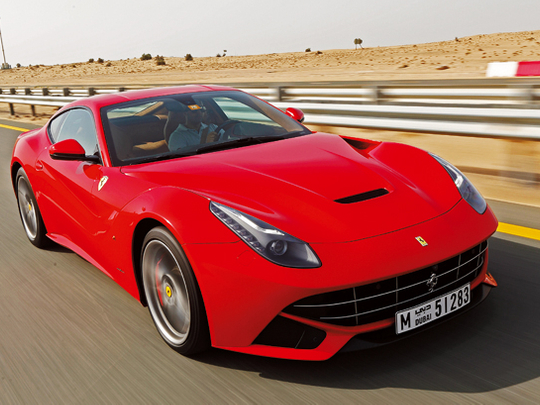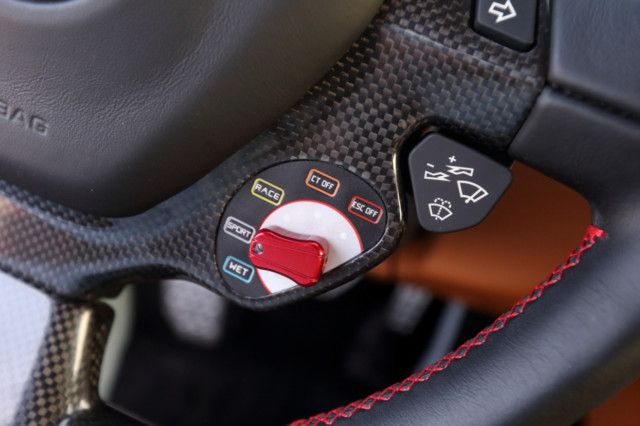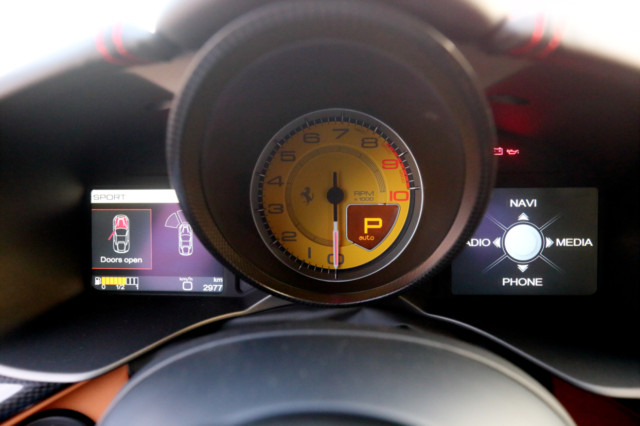
Even before we start, the F12 Berlinetta is at a substantial disadvantage. As stark numbers go, the latest Ferrari GT doesn’t compare favourably with its chief rival, the Lamborghini Aventador, on two oft-touted performance parameters.
Granted the F12 is vastly more powerful, but the Aventador has the advantage of a clever all-wheel drive system that makes it faster in the real world. If we lay out the cold hard figures the F12 is two-tenths of a second slower to 100kph and runs out of legs at a pedestrian 340kph as opposed to the Aventador’s 350kph-plus V-max.
For the sort of people who engage in spec-sheet sabre-rattling, that alone is worth the latter’s Dh300,000 price premium right there. However, judging the F12 purely on these largely meaningless numbers would be missing the point. Let me explain.
As the new Maranello GT flagship, the F12 outperforms the superb 599 GTB on every count — especially when it comes to dynamics. The F12 is 50mm shorter and 20mm narrower and sits on an abbreviated wheelbase. It’s lighter too. Weighing 1,525kg (dry) it is 70kg less lardy than the 599.
Now drop 730 horsepower into the equation and you end up with a stratospheric power-to-weight ratio of 478bhp-per-tonne. And that, Mr Spec Enthusiast, is better than the Aventador’s and not too far off the mighty Bugatti Veyron’s. Predictably, this lightness translates into huge pace, and more importantly, staggering agility. But let’s come back to that in a bit.
The F12’s reign as Ferrari’s flagship was short-lived; the LaFerrari is now perched at the top of the company’s pecking order. However, it is Grand Tourers not mid-engined monsters that are traditionally the core of the company. A V12 sitting front-midship, rear-wheel drive and strictly room for two in the cabin.
The long bonnet and stubby back are clear and present, and there are no comedy spoilers or yawning vents. Although you’d never realise from the conspicuous lack of in-your-face aerodynamic devices, the F12 generates 123kg of downforce at 200kph — that’s the equivalent of having a burger-scoffing fat person strapped to the roof of the car. In fact, it is 76 per cent more than the old 599, which could only muster a relatively waif-like 30kg of negative lift at same speed.
The neat-looking aero-bridge upfront smoothly channels air around the side of the car, while openings above the rear wheels vent pressure that builds up in the wheel-wells as the speed rises, thereby reducing drag.
Other aero-trickery includes an active brake cooling
system with automatically opening guide vanes, and as many as five outlets underneath that allow the F12 to forge
a path of least resistance through
the air.
New Porsche 911 GT3 reviewed
However, it is underneath the unfussy bodywork that all the fiddly Nasa-grade engineering lies. The 6.3-litre V12 now sits 25mm closer to the ground to lower the centre of gravity and most heavy components are contained within the car’s 2,718mm wheelbase.
In true Ferrari GT tradition the gearbox sits at the back, rendering the F12 a tad fat bottomed with 54 per cent of the weight sitting over the rear axle.
But what is it like to drive? Hazard a guess… It is dribbling insane. Press the innocuously marked button on the surprisingly uncluttered centre console to activate launch control, hold the brakes, and rev the V12 to a muzzled 3,000rpm.
Release the anchors and the 315-section rear tyres light up with the assault of 730-strong cavalry, detonating the F12 off the line with alarming might. The rev needle knocking the 8,750rpm redline with steely determination. Into second and 100kph is conquered in 3.1 seconds.
There is no appreciable drop in power as the seven-speed double clutch gearbox rifles through the ratios. No torque troughs, no head-nodding between gearshifts just one constant surge of power that thumps you in the guts like an invisible and omnipotent force.
The 200kph mark is shattered in a faintly ridiculous 8.5 seconds (about the same as the 918 Spyder we drove last week) as the F12 reels in the horizon and spits it out of the rear-view mirror with mind-bending ferocity.
The blinding speed comes courtesy of the 6.3-litre V12 plucked out of the FF, but it has undergone comprehensive surgery here. The block loses the FF’s AWD shaft and is unique to the F12. And even though the capacity remains unaltered, the F12’s engine gets a higher compression ratio, improved breathing and new cams. Consequently it revs higher, goes harder and the cut-off now sits at a bewildering 8,750rpm.
In fact, Ferrari claims that so long as you’re above 2,000rpm, 90 per cent of this savage acceleration is served up in a smidge over half a second. And I can attest that’s not just PR fluff; the responsiveness of the throttle is immediate.
But what impresses more than the belligerent straight-line pace or the racecar-like yowls and barks of V12, is the clarity of the F12’s responses. It makes the Aventador feel like it’s made of mud. Be warned, though, the F12 is not a car that you can just jump in and drive fast straightaway. There is the initial acclimatisation period, which must be approached with caution. Well at least if you don’t want to end up tangled in a smouldering mass of the 12 different alloys and exotic materials that constitute the F12’s space frame.
It’s unexpectedly nervous on our sand-slicked roads when the tyres are cold and the ridiculously fast steering (two turns lock-to-lock and quicker than the 458’s set-up) further compounds the overall twitchiness.
Even though the engineers have apparently dialed in a touch of understeer at the limit, head into the corner with your foot floored or accelerate too early out of a bend and you will be treated to pupil-dilating oversteer. Since the tiniest inputs from the steering wheel and the throttle have a profound effect, the F12 swiftly penalises the clumsy.
However, as you continue driving and recalibrate your synapses to keep pace with the F12’s lightning-quick responses, things start coming together. The turn-in is immediate and the steering, although light, weighs up progressively as the nose darts into a bend. All the major components work single-mindedly towards the goal of hastening your progress around corners. As you begin pushing the F12 harder, it surpasses your expectation on every level.
But astonishingly despite its gnat-like ability to change direction, there is almost no perceptible body roll — it doesn’t slosh from side to side even when you’re bombing through a series of tightening esses, thanks to the latest generation adaptive magnetorheological suspension.
The system constantly monitors several parameters and adjusts the damping on the fly to quell pitch and squat, while a control software bespoke to the F12, manages the electronics, including the traction control, differential and stability control.
Last, but by no means least, are the F12 carbon-ceramic brakes, which are by far the best I’ve experienced on any road car. Not only do the 398mm:360mm front:rear discs have astounding efficacy even after hours of hard punishment, they have superb feel at the top of the pedal travel — something sorely lacking in most similar set-ups. As far as sheer driving sensation goes — so long as you’re paying attention — the F12 is almost perfect.
And here’s the clincher: despite its quasi racecar dynamics and the spine-tingling V12 opera, the F12 is much more civilised than you’d expect a car this potent to be. The ride’s supple and the engine is deliciously tactile in urban driving situations.
It doesn’t groan and hiss while trickling between traffic lights, and since a substantial chunk of the power is available over a wide rev band, overtaking is a gleeful affair when the opportunity presents itself. Provided you can get your head around the stupidly contrived on-steering indicator switches, it’s a car you could realistically use everyday.
Overall, the F12 is not as flamboyant or dramatic as the Aventador, but it is by no means a wallflower. Driving either of them will make you look like someone in dire need of acknowledgement, only a tad less so in the F12. That said, the F12 Berlinetta is more engaging to drive.
Everything about it, from the way it sounds to the lucidity with which it goes, stops and turns, is near magical. It is one of those rare cars that successfully intertwine engineering purity with — and I’m loathe to use the expression — soul and passion. Now whip out your biggest calculator, and try explaining that in numbers.














